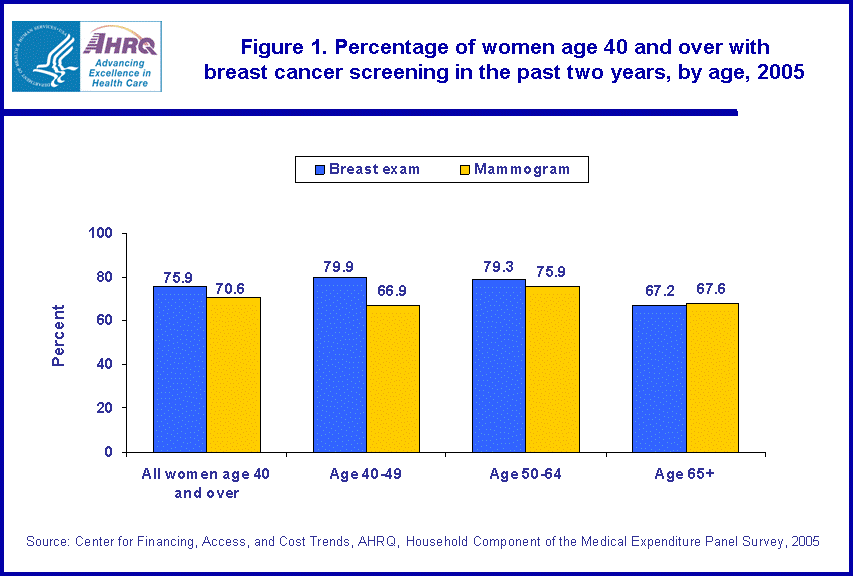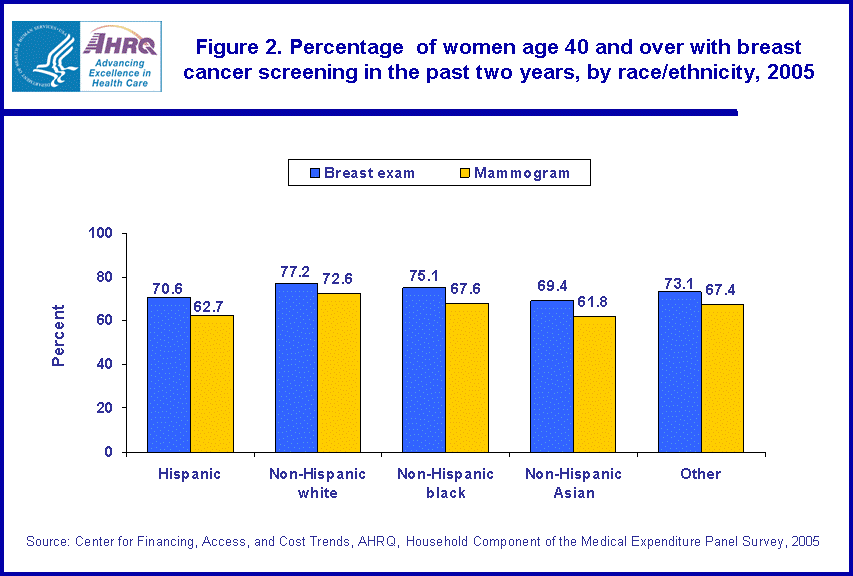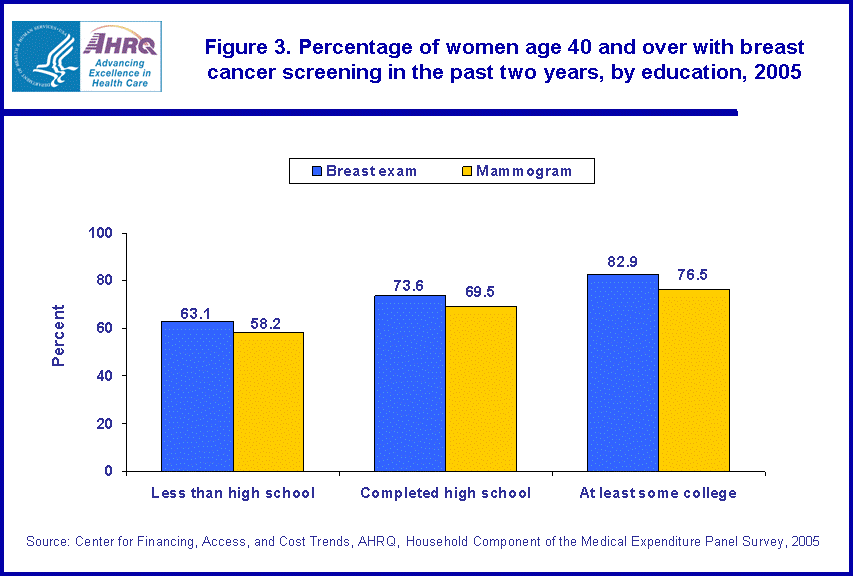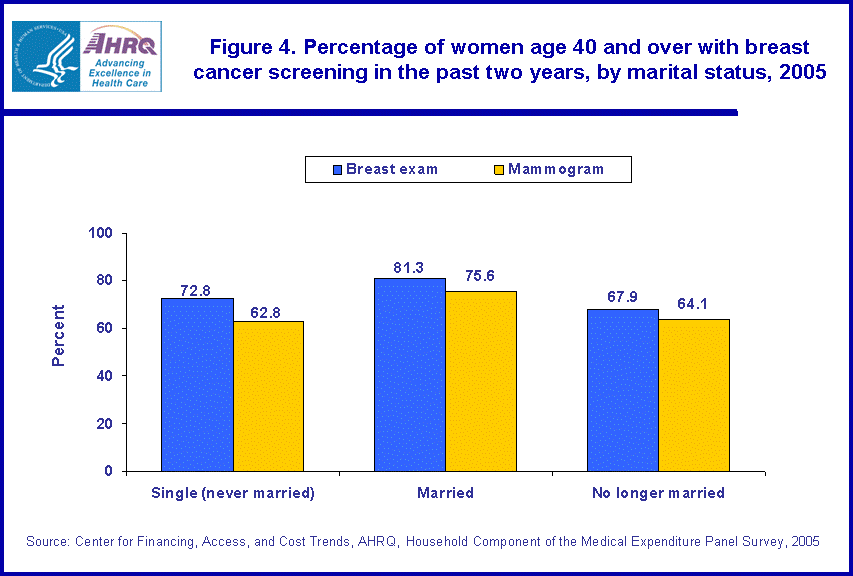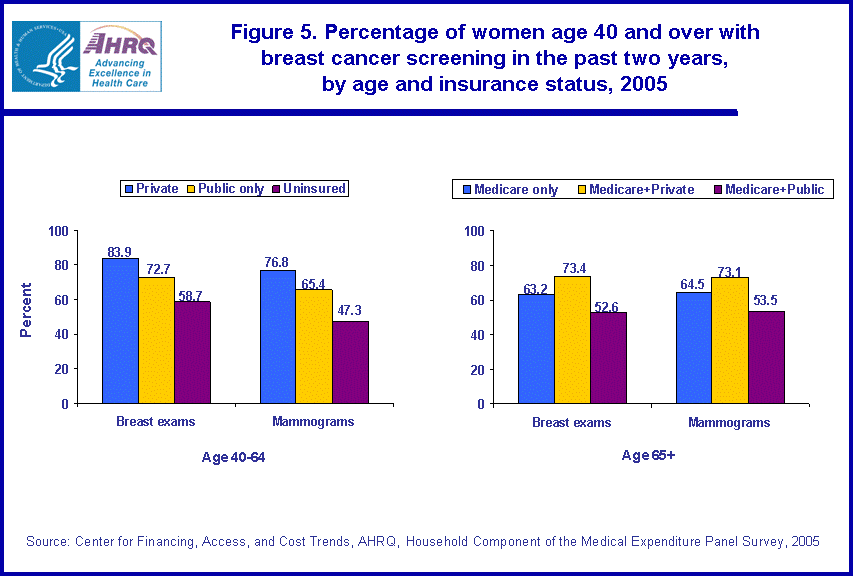STATISTICAL BRIEF #170: |
|||||||||||||||||||||||||||||||||||||||||||||||||||||||||||||||||||||||||||||||||||||||||||||||||||||
| June 2007 | |||||||||||||||||||||||||||||||||||||||||||||||||||||||||||||||||||||||||||||||||||||||||||||||||||||
| Anita Soni, PhD |
|||||||||||||||||||||||||||||||||||||||||||||||||||||||||||||||||||||||||||||||||||||||||||||||||||||
Highlights
|
|||||||||||||||||||||||||||||||||||||||||||||||||||||||||||||||||||||||||||||||||||||||||||||||||||||
IntroductionBreast cancer is one of the top 10 causes of death for women in United States. Regular breast exams and mammograms are the best tools available to doctors to find breast cancer early. When breast cancer is found early, the five-year survival rate is 96 percent. The U.S. Preventive Services Task Force recommends screening mammography, with or without clinical breast examination, every one to two years for women age 40 and over. This Statistical Brief provides estimates of the extent to which women age 40 and over reported receiving breast exams and mammograms for breast cancer detection in 2005. The estimates presented are derived from data collected in the Household Component of the Medical Expenditure Panel Survey (MEPS-HC) questionnaire. All differences discussed in the text are statistically significant at 0.05 or better. |
|||||||||||||||||||||||||||||||||||||||||||||||||||||||||||||||||||||||||||||||||||||||||||||||||||||
FindingsBreast exams and mammograms are the best methods available to women for detection of breast cancer. In 2005, more than three out of four (75.9 percent) women age 40 and over reported having received a breast exam, and over two-thirds (70.6 percent) reported having received a mammogram within the last two years (see Definitions) (figure 1). On the other hand, about one of every 10 (10.2 percent) women age 40 and over reported they had never received a mammogram (estimate not shown in figures). Variations in rates of breast exam and mammograms by selected characteristics of women are described below. Age Women age 65 and above were less likely to have received a breast exam within the last two years than women age 40 to 49 and 50 to 64 (67.2 versus 79.9 percent and 79.3 percent, respectively) (figure 1). Women between the age of 50 and 64 were more likely to have received mammograms within the last two years (75.9 percent) than women between 40 and 49 (66.9 percent) and 65 and older (67.6 percent). Race/ethnicity Non-Hispanic white women were more likely to have received breast exams within the last two years (77.2 percent) than non-Hispanic Asian (69.4 percent) or Hispanic (70.6 percent) women (figure 2). A lower percentage of non-Hispanic Asian and Hispanic women reported having received mammograms within the last two years as compared with non-Hispanic white women (61.8 percent and 62.7 percent, respectively, versus 72.6 percent). Hispanic women were more likely to have never received a mammogram than non-Hispanic white women (15.4 percent versus 9.1 percent) (estimates not shown in figures). Educational level The likelihood of having a breast exam within the past two years increased with education, ranging from 63.1 percent for women with less than a high school education to 82.9 percent for those with at least some college education (figure 3). Educational level was also found to be related to receiving mammograms within the last two years. A higher percentage of women with at least some college education received mammograms within the last two years as compared with those with less than a high school education (76.5 percent versus 58.2 percent). Marital status Married women were more likely to have received a breast exam within the last two years than single (never married) or no-longer married women (81.3 percent versus 72.8 percent and 67.9 percent, respectively) (figure 4). Married women were also more likely to have received mammograms within the last two years than women who were never married or no longer married (75.6 percent versus 62.8 percent and 64.1 percent, respectively). Insurance status Women age 40 to 64 covered by private insurance were more likely to have received a breast exam within the last two years (83.9 percent) than those who were covered by public insurance (72.7 percent), while those who were uninsured (58.7 percent) were substantially less likely to have had a breast exam than those with public or private insurance (figure 5). Among women age 65 and over, those with Medicare and supplemental private insurance coverage were more likely to have had a breast exam within the last two years (73.4 percent) than those with Medicare only (63.2 percent) or Medicare and some other public insurance (52.6 percent). More than three of every four women under age 65 covered by private insurance reported having received a mammogram within the last two years (76.8 percent) as compared with about two-thirds of women who were covered only by public insurance (65.4 percent) and less than half of those who were uninsured (47.3 percent). Among women age 65 and over, those with Medicare and supplemental private insurance coverage were more likely to have received a mammogram within the last two years (73.1 percent) than those with Medicare only (64.5 percent) or Medicare and some other public insurance (53.5 percent). |
|||||||||||||||||||||||||||||||||||||||||||||||||||||||||||||||||||||||||||||||||||||||||||||||||||||
Data SourceThe estimates in this brief were derived from the MEPS 2005 full-year population characteristics data file (HC-090). |
|||||||||||||||||||||||||||||||||||||||||||||||||||||||||||||||||||||||||||||||||||||||||||||||||||||
DefinitionsQuestions related to receiving breast exams and mammograms were asked in the Preventive Care section of MEPS-HC. Clinical breast exam A clinical breast exam is an examination by a doctor or nurse, who uses his or her hands to feel for lumps or other changes. Mammogram A mammogram is an X-ray of the breast. Mammograms are the best method to detect breast cancer early, when it is easier to treat and before it is big enough to feel or cause symptoms. Having regular mammograms can lower the risk of dying from breast cancer. Racial and ethnic classifications Classification by race and ethnicity is based on information reported for each family member. Respondents were asked if each family member was Hispanic or Latino. Respondents were also asked which race or races best describes each family member. Race categories include white, black/African American, American Indian or Alaska Native, Asian, Native Hawaiian or other Pacific Islander, and other. Based on these questions, sample persons were classified into the following race categories: Hispanic single race, non-Hispanic white single race, non-Hispanic black single race, non-Hispanic Asian single race, and other (Hawaiian/Pacific Islander non-Hispanic, American Indian/Alaska Native non-Hispanic, and multiple races non-Hispanic). Marital status The category "No Longer Married" includes the women who are widowed, divorced or separated. Educational level Educational level indicates a persons number of years of education at the time of the first MEPS interview:
This refers to the two years before the MEPS interview in which this question was asked. Health insurance status Individuals under age 65 were classified in the following three insurance categories based on household responses to health insurance status questions:
|
|||||||||||||||||||||||||||||||||||||||||||||||||||||||||||||||||||||||||||||||||||||||||||||||||||||
About MEPS-HCMEPS-HC is a nationally representative longitudinal survey that collects detailed information on health care utilization and expenditures, health insurance, and health status, as well as a wide variety of social, demographic, and economic characteristics for the civilian noninstitutionalized population. It is cosponsored by the Agency for Healthcare Research and Quality and the National Center for Health Statistics. For more information about MEPS, call the MEPS information coordinator at AHRQ (301-427-1656) or visit the MEPS Web site at http://www.meps.ahrq.gov/. |
|||||||||||||||||||||||||||||||||||||||||||||||||||||||||||||||||||||||||||||||||||||||||||||||||||||
ReferencesFor a detailed description of the MEPS survey design, sample design, and methods used to minimize sources of nonsampling error, see the following publications: Cohen, J. Design and Methods of the Medical Expenditure Panel Survey Household Component. MEPS Methodology Report No. 1. AHCPR Pub. No. 97-0026. Rockville, Md.: Agency for Health Care Policy and Research, 1997. Cohen, S. Sample Design of the 1996 Medical Expenditure Panel Survey Household Component. MEPS Methodology Report No. 2. AHCPR Pub. No. 97-0027. Rockville, Md.: Agency for Health Care Policy and Research, 1997. Cohen, S. Design Strategies and Innovations in the Medical Expenditure Panel Survey. Medical Care, July 2003: 41(7) Supplement: III-5-III-12. For information on breast cancer screening and mammograms, see the following: Breast cancer screening: Basic information: http://www.cdc.gov/cancer/breast/basic_info/screening.htm Recommendations and rationale: Screening for Breast Cancer. U.S. Preventive Services Task Force (USPSTF) https://www.uspreventiveservicestaskforce.org/Page/Document/RecommendationStatementFinal/breast-cancer-screening1 Mammograms: https://www.cdc.gov/cancer/breast/basic_info/mammograms.htm NCI Fact sheet: Screening Mammograms--Questions and Answers: https://www.cancer.gov/types/breast/mammograms-fact-sheet Breast cancer: Early detection: https://www.cdc.gov/cancer/nbccedp/ |
|||||||||||||||||||||||||||||||||||||||||||||||||||||||||||||||||||||||||||||||||||||||||||||||||||||
Suggested CitationSoni, A. Use of Breast Cancer Detection Exams among Women Age 40 and Over, U.S. Noninstitutionalized Population, 2005. Statistical Brief #170. June 2007. Agency for Healthcare Research and Quality, Rockville, Md. http://www.meps.ahrq.gov/mepsweb/data_files/publications/st170/stat170.shtml AHRQ welcomes questions and comments from readers of this publication who are interested in obtaining more information about access, cost, use, financing, and quality of health care in the United States. We also invite you to tell us how you are using this Statistical Brief and other MEPS data and tools and to share suggestions on how MEPS products might be enhanced to further meet your needs. Please e-mail us at MEPSProjectDirector@ahrq.hhs.gov or send a letter to the address below: Steven B. Cohen, PhD, Director Center for Financing, Access, and Cost Trends Agency for Healthcare Research and Quality 540 Gaither Road Rockville, MD 20850 |
|||||||||||||||||||||||||||||||||||||||||||||||||||||||||||||||||||||||||||||||||||||||||||||||||||||
| |||||||||||||||||||||||||||||||||||||||||||||||||||||||||||||||||||||||||||||||||||||||||||||||||||||

|
|
Font Size:
|
||||
|
|
|
|
||||



